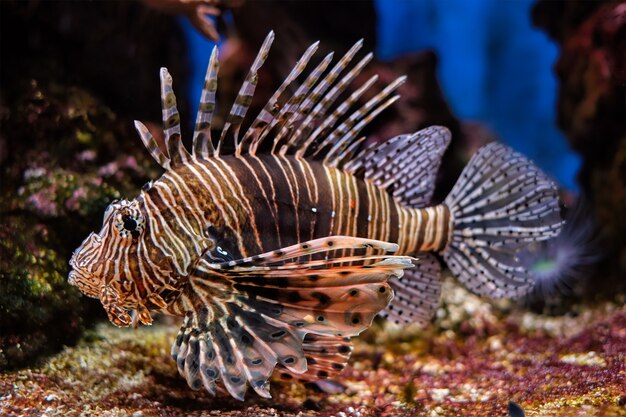ANIMAL: Red Lionfish Pterois volitans Type of Animal: Scorpionfish Habitat: Reefs, rocky crevices, seagrass areas, wrecks, rocky areas, pilings, lagoons, mangroves, estuaries Location(s): Native to Indo-Pacific. Introduced/invasive in Atlantic from E coast of US through Gulf of Mexico & Caribbean down to Uruguay. Also introduced/invasive in E Mediterranean. Appearance: Laterally compressed somewhat deep body, striped graceful-looking fish w/ red, red-brown, & white stripes, long showy pectoral fins, pale white belly, long venomous spines along dorsal/anal/pelvic fins, some spotting along fins Food/Diet: Fish (including each other), crabs, shrimp, squid, krill Status in Wild: Stable Conservation: Not Applicable Lifestyle: Solitary or harems of a male w/ 2-10 females. Juveniles found alone or in groups of 3-10. Additional Info: Called: Male Female Young: Fry Group: School Weight: Male: 2.5 lbs Female: 2 lbs Gestation: 1.5 days Life Span: 10-20 years Body Length: Male: 1.25-1.5 ft Female: 1-1.25 ft Young: 1 in Tail Length: 1.8-2 in, same for both sexes Main predators of adults are sharks, eels, groupers, cornetfish, larger lionfish, other scorpionfish, frogfish (in fights to death), snappers, barracuda, triggerfish, monkfish, & birds. Trumpetfish eat small juveniles. Males extremely territorial, w/ fights often resulting in death. Male will try to bite head of other male. Many males seen w/ parts of mouth torn off. Also called Red Firefish, Red Zebrafish, Red Turkeyfish, Peacock Lionfish, Indo-Pacific Red Lionfish, & Butterfly Cod, among others. Spawning occurs year-round. Single female can release egg mass of 12,000-50,000 eggs as much as 10 times per month. As female spawns, male releases sperm fertilizing eggs. Both sexes mate w/ multiple partners & females can release up to 6 million eggs a year making these fish extremely fecund. These fish extremely invasive in introduced range due to high reproductive rate, predatory nature, & competition w/ native fish. While they have predators, they’re not favorite prey item due to venomous spines. Lionfish invasions most likely stem from aquarists releasing them into sea. Lionfish invasion in Gulf of Mexico & Caribbean may have stemmed from as little as 3 lionfish. To combat invasions, these fish fished for meat which is not poisonous. Fun Fact(s): Dorsal/anal/pelvic fins have highly venomous spines used in defense. These spines cause extremely painful stings/puncture wounds lasting for hours to even days. Effects of venom throbbing pain, swelling, bleeding, numbness, redness, bruising, skin discoloration, respiratory distress, nausea, & vomiting. Deaths have occurred from stings. Venom neurotoxic. These fish can even sting if dead. Stings usually occur because someone was handling it. When disturbed, they raise feathery fins as warning & flee if given chance. If cornered, they’ll charge.
